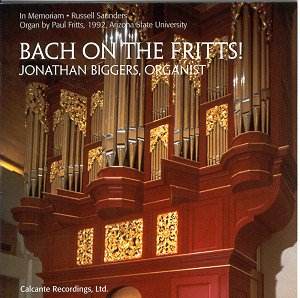The aim of this CD seems to be the exploration of Bach’s
fluent and inspired organ writing within various musical forms and the
blending of these forms with the different colours of the organ.
It remains unclear whether the Toccata, Adagio and
Fugue in C-Minor (BWV564), which has a clearly Italian influence,
is based on Italian concertos. As Bach scholar Peter Williams notices,
it ‘remains a highly original example of organ form developed from elements
current in and after 1700, with sections not only independent but each
given a length, a form and a style not very like anything else’. The
Partita on ‘Sei gegrüsset, Jesu gütig’ (BWV
768) is based on a chorale melody and it is Bach’s longest set of variations
- eleven in total. The Prelude and Fugue in A-Minor (BWV 543),
composed by young Bach, combines the characteristics of the North German
‘stylus phantasticus’ i.e. virtuosi manual and pedal parts with rhythmic
and harmonic enrichment. The fugue is dynamic and dance-like. On the
other hand, the Prelude and Fugue in A-Major (BWV 536) opens
with a gentle prelude, which is followed by a rich contrapuntal fugue.
The Chorale Prelude ‘Schmücke dich, o liebe Seele’ (BWV
654) reveals Bach’s ability to vocalize a chorale melody for the organ
and the result is one of the most beautiful chorale preludes, whereas
the Chorale Prelude ‘Wenn wir in höchsten Nöten’ (BWV
668a) founds its expression through its simplicity, which seems to derive
from the choral text. As far as the Passacaglia in C-Minor (BWV
582), is concerned, it is Bach’s only example in the key; a monumental
and advanced composition based onto a 8 measure theme with 20 variations
on the melody and a fugue to accompany it.
The organ used is that of Arizona State University,
Temple, built by Paul Fritts in 1992. The accompanying notes describe
in detail the builder’s idea to make an organ, which is strongly influenced
by historic practice. It is an organ ‘based on the Dutch-North German
style of the 17th century, synthesized in the work of Arp
Schnitger’. The high, rectangular shape of the room, together with the
masonry walls and the case-work of the organ provide a very good acoustic;
over four seconds of clear reverberation when empty.
Unfortunately, Jonathan Biggers seems neither to blend
nicely the different colors of the organ with the needs of the pieces,
nor takes care of the room’s acoustic. The organ quite often sounds
blurred. Any effort to articulate disappears and the result is a feeling
of unnatural breathing. In the Toccata, Adagio and Fugue in C-Minor,
the pedal line is destroyed by the chosen registration and the lower
register sounds muddy, without articulation. Biggers could be more adventurous
in the chosen registrations of the ‘Sei gegrüsset, Jesu
gütig’. Here he misses the opportunity to make use of the
manual reeds to separate the hands between the two manuals. As a result,
the piece starts to sound dull after the first couple of variations.
The piece lacks a sense of unity in relation to the chosen tempi of
each variation. Too much rubato gives an inappropriate romantic feeling.
Variation 1 misses its melismatic character and variations 3, 6, and
8 presents a blurred bass line. The Preludes and Fugues in A-Minor
and A-Major sounds uninteresting with fast playing (Prelude in A-Minor),
which cannot cope with the acoustics and presents a static feeling (Prelude
in A-Major and Fugue in A-Minor without the dancing mood). The ornaments
in the Chorales Preludes are not vocalized enough, but their
performances are the most persuasive of the whole CD. The Passacaglia
in C-Minor carries too much rubato, ornaments that are bot sufficiently
crisp and an unstable tempo that starts slowly and ends up rather fast.
Christina Antoniadou


